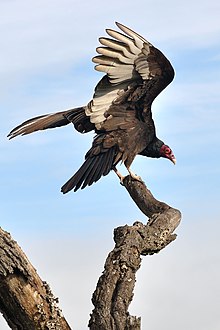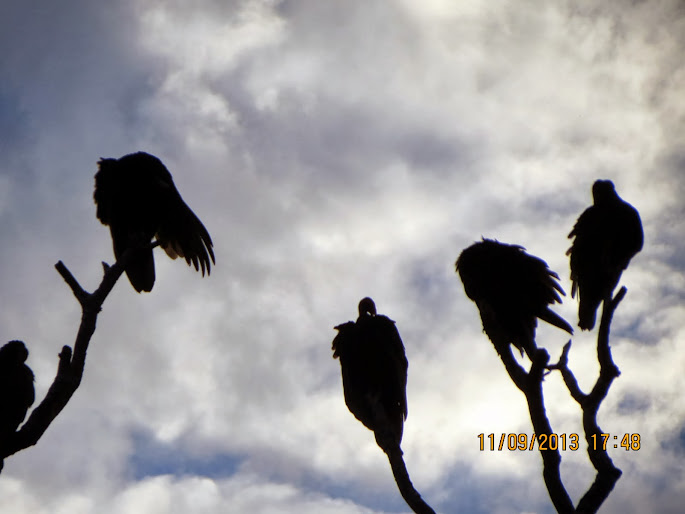
Hi Everybody!!
November is Turkey Buzzard Month for me (as others are just talking Turkey). It is the time when the Buzzards return to Rainbow Creek for the winter. The "buzz" around the neighborhood is that 'brendasue's buzzards are back! As a child, I did not plan to grow up to be the 'old buzzard lady'; but that is what happened. Today I was quite happy to look up and a few buzzards are in the old buzzard tree. It is the first time I sat down just to hang out with them since last March when they left. They allow me to sit on the ground by the tree with my camera as they get busy cleaning the feathers (which takes most of their time). As you will see in the photostudy pics, it was also quite a day for sky watching with cool clouds. I do have 2 of the buzzards named-(King Buzz and JerryBuzz). I see, by looking at your photos from around the whole world, that no other person on Earth names the birds they photograph. I think it is because no other person knows a buzzard! You can see in my photo albums at the G+ Gallery, these are the same birds year after year coming to the same old buzzard tree. I do not know why in all the forest they chose this tree, but they did. I am lucky to witness these birds. I hope You will all get to know Birds. Enjoy!

https://en.wikipedia.org/wiki/Turkey_Vulture
Turkey Vulture
From Wikipedia, the free encyclopedia
The Turkey Vulture (Cathartes aura), also known in some North American regions as theturkey buzzard (or just buzzard), and in some areas of the Caribbean as the John crowor carrion crow,[2] is the most widespread of the New World vultures.[3] One of three species in the genus Cathartes, in the family Cathartidae, the Turkey Vulture ranges from southern Canada to the southernmost tip of South America. It inhabits a variety of open and semi-open areas, including subtropical forests, shrublands, pastures, and deserts.[1]
It, like all New World vultures, is not related to the Old World vultures of Europe, Africa, and Asia. It looks nearly identical because of convergent evolution, where natural selection similarly shapes unrelated animals adapting to the same conditions.
The Turkey Vulture is a scavenger and feeds almost exclusively on carrion.[4] It finds its food using its keen eyes and sense of smell, flying low enough to detect the gases produced by the beginnings of the process of decay in dead animals.[4] In flight, it usesthermals to move through the air, flapping its wings infrequently. It roosts in large community groups. Lacking a syrinx—the vocal organ of birds—its only vocalizations are grunts or low hisses.[5] It nests in caves, hollow trees, or thickets. Each year it generally raises two chicks, which it feeds by regurgitation.[6] It has very few natural predators.[7] In the United States, the vulture receives legal protection under the Migratory Bird Treaty Act of 1918.[8]
| Turkey Vulture | |
|---|---|
 | |
| At Santa Teresa County Park, San Jose, California, US | |
| Conservation status | |
| Scientific classification | |
| Kingdom: | Animalia |
| Phylum: | Chordata |
| Class: | Aves |
| Order: | Incertae sedis (disputed) |
| Family: | Cathartidae |
| Genus: | Cathartes |
| Species: | C. aura |
The Turkey Vulture species receives special legal protections under the Migratory Bird Treaty Act of 1918 in the United States,[8] by the Convention for the Protection of Migratory Birds inCanada,[57] and by the Convention for the Protection of Migratory Birds and Game Mammals inMexico.[57] In the USA it is illegal to take, kill, or possess Turkey Vultures, and violation of the law is punishable by a fine of up to $15,000 and imprisonment of up to six months.[56] It is listed as a species of Least Concern by the IUCN Red List. Populations appear to remain stable, and it has not reached the threshold of inclusion as a threatened species, which requires a decline of more than 30 percent in ten years or three generations.[1]
Description[edit]
A large bird, it has a wingspan of 160–183 cm (63–72 in), a length of 62–81 cm (24–32 in), and weight of 0.8 to 2.3 kg (1.8 to 5.1 lb).[22][23][24] While birds in the Northern limit of the species' range average around 2 kg (4.4 lb), vulture from the neotropics are generally smaller, averaging around 1.45 kg (3.2 lb).[25][26] It displays minimal sexual dimorphism; sexes are identical in plumage and in coloration, although the female is slightly larger.[27] The body feathers are mostly brownish-black, but the flight feathers on the wings appear to be silvery-gray beneath, contrasting with the darker wing linings.[22] The adult's head is small in proportion to its body and is red in color with few to no feathers. It also has a relatively short, hooked, ivory-colored beak.[28] The irises of the eyes are gray-brown; legs and feet are pink-skinned, although typically stained white. The eye has a single incomplete row of eyelashes on the upper lid and two rows on the lower lid.[29]
The two front toes of the foot are long and have small webs at their bases.[30] Tracks are large, between 9.5 and 14 cm (3.7 and 5.5 in) in length and 8.2 and 10.2 cm (3.2 and 4.0 in) in width, both measurements including claw marks. Toes are arranged in the classic, anisodactyl pattern.[31] The feet are flat, relatively weak, and poorly adapted to grasping; the talons are also not designed for grasping, as they are relatively blunt.[3] In flight, the tail is long and slim. The Black Vulture is relatively shorter-tailed and shorter-winged, which makes it appear rather smaller in flight than the Turkey vulture, although the body masses of the two species are roughly the same. The nostrils are not divided by a septum, but rather are perforate; from the side one can see through the beak.[32] It undergoes a molt in late winter to early spring. It is a gradual molt, which lasts until early autumn.[6] The immature bird has a gray head with a black beak tip; the colors change to those of the adult as the bird matures.[33] How long turkey vultures can live in captivity is not well known. While 21 years is generally given as a maximum age, the Gabbert Raptor Center on the University of Minnesota campus is home to a turkey vulture named Nero with a confirmed age of 37.[clarification needed] There is another female bird, named Richard, living at the Lindsay Wildlife Museum in Walnut Creek, CA that hatched in 1974 and arrived at the museum later that year.[34] The oldest wild captured banded bird was 16 years old.[4]
Leucistic (sometimes mistakenly called "albino") Turkey Vultures are sometimes seen.[35] The well-documented records come from the United States of America, but this probably reflects the fact that such birds are more commonly reported by birders there, rather than a geographical variation. Even in the United States, white Turkey Vultures (although they presumably always turned up every now and then) were only discussed in birder and raptor conservation circles and are not scientifically studied.[36]
The Turkey Vulture, like most other vultures, has very few vocalization capabilities. Because it lacks a syrinx, it can only utter hisses and grunts.[5] It usually hisses when it feels threatened. Grunts are commonly heard from hungry young and from adults in their courtship display.



https://en.wikipedia.org/wiki/Personal_grooming
Personal grooming (also called titivating and preening) is the art of cleaning, grooming, and maintaining parts of the body. It is a species-typical behavior.
In animals[edit]
Individual animals regularly clean themselves and put their fur, feathers or other skincoverings in good order. This activity is known as personal grooming, a form of hygiene. Extracting foreign objects such as insects, leaves, dirt, twigs and parasites,[1] are all forms of grooming. Among animals, birds spend considerable time preening theirfeathers. This is done to remove ectoparasites, keep them in good aerodynamic condition, and waterproof them. To do that, they use the preen oil secreted by theuropygial gland, the dust of down feathers, or other means such as dust-bathing oranting. During oil spills, animal conservationists that rescue penguins sometimes dress them in knitted sweaters to stop them from preening and thereby ingesting the mineral oil which is poisonous. Monkeys may also pick out nits from their fur or scratch their rears to keep themselves clean. Felidae cats are well known for their extensive grooming. One reason advanced for such grooming is to remove all traces of blood and other matter so as to not alert prey with the scent. Cats groom so much that they often produce hairballs from the fur they ingest.[2]
Grooming as a social activity[edit]
Main article: Social grooming
Many social animals adapt preening and grooming behaviors for other social purposes such as bonding and the strengthening of social structures. Grooming plays a particularly important role in forming social bonds in many primate species, such aschacma baboons and wedge-capped capuchins.









...this is brendasue signing off from Rainbow Creek. See You next time!

Link to photostudy:
https://plus.google.com/photos/117645114459863049265/albums/5945542050561801105


Goodnight!
O+O



No comments:
Post a Comment
Hi Everybody! Please say hello and follow so I know you are here! Due to the inconsideration of people trying to put commercials on my blog comment area, I have restricted use of anonymous posts. Sorry that some hurt all.
My public email is katescabin@gmail.com No spammers or trolls